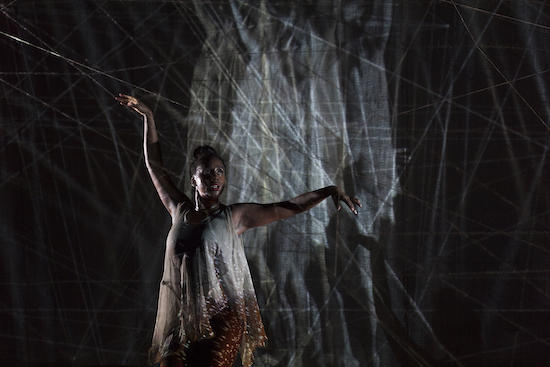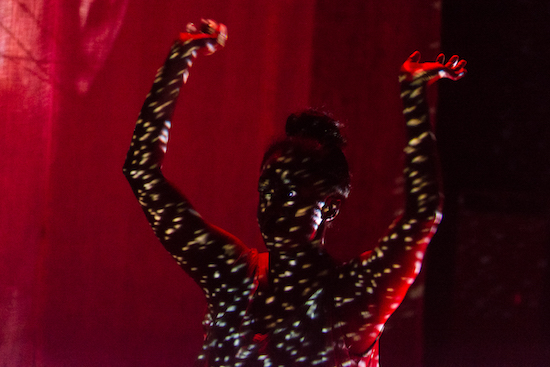Credit: Sarah Hickson
“This is the beginning of DISTORTED CONSTELLATIONS … a ritualised journey through my neural architecture”; through a pair of headphones Nwando Ebizie’s voice repeats an invitation to move outside your own perception and join her in an exploration of her own neurophenomenology. The ceiling of this antechamber is covered in parachute silk, cushions, soft lighting, it is a zone that wants you to think.
In the moments before the performance, voice and text ask us to consider that we all exist on the neural spectrum at divergent points. Her voice, experienced sitting in a temporary area, a place to occupy before you cross the threshold into a labyrinth that is mythopoetic, Afrofuturist, disjointed, glittered and hyper-layered.
Speculative conversations are erupting between visitors, a sense of wayfinding neural pathways and processing environment is shared through discussion. My thoughts join these speculations questioning the value of reality, how my brain processes it and how memories make their journey from the short to the long term through dyslexic gaps, blanks and holes. Through engaging with the subjectivity of our own reality, we become open to the exchanges held within the work.
DISTORTED CONSTELLATIONS immerses the viewer in Ebizie’s own neural-architecture, sharing her perceptual reality, its inner and outer states through a multi-sensory installation and performance for the direct engagement of an audience. The work makes manifest the neurological disorder known as “Visual Snow” that disrupts the field of vision with interference and static, filling the known world with the flickering dots of a detuned television, gaps filled with a sense of depersonalisation and anxiety. Within the alternate reality of the installation, our understanding of vision is tested through a transient manifestation of the artist’s body in the performance, “20 Minutes of Action”. Here we join a mapping of visual auras, afterimages, the rising & falling of dots and the intersubjective depiction of neural networks. A pan-field dynamic visual disturbance in which Ebizie’s own Pailin (again) Opsia (seeing) is present, repeated, ritualised and enacted as myths.
The performances score for “20 Minutes of Action” is played as 360 degrees of immersive sound enabling noise to surround the body in a multisensory environment of vision and movement. Within a white cube of a room once used for cold storage in Caustic Coastal studios, Ebizie’s body moves through the partitions, layers, and reflective ground of the landscape. At the base of her spine is a line of lights that become a beacon in the frequencies and repetition of visual snow. Sound and body gather speed, focus is disrupted and the body reforms itself and its layers of archaeology through the replaying of myth. The deaths experienced through life are marked as symbolic “Descansos” funeral memorials at the side of the road, places where paths have been taken and choices made.
Her body diffused into space, its footsteps echo, tapping, falling into death drops returning, to ascend again. The demise and resurrection of the queered black ballroom body joined and meshed with the Haitian dances Yanvalou and Petwo. These movements fierce, made to incite revolution, to create the conditions for change, to heal wounds. Marsha P. Johnson in high drag at the Stonewall Riots, Ezili Dantor mother protector create spaces of resilience, places from which to mark and return. Shared poetics through a ground that is ruptured, amorphous and pulsing.

Credit:Steven Pocock
The floor where Ebizie’s body rises and collapses is glossy like an oil spill. In this spirit mirror her reflection makes a doubled form, one that shifts and modulates with the sound. Life is reversed, reencountered marked and remembered through the recollection of movements recalled through deep archaeology. Sound becomes sirens, signals, markers of visceral emergency, they cut through distance and time.
Then just as the work builds, it switches; the sound of the rising and falling of waves, the shoreline fringed with dots. High and low tide, the rhythms of the ocean created by the gravitational pull of the planets. Ebizie slowly moves through the audience gathered in the architecture she created. We are enmeshed within the work. The building of pressure through the installation recedes, is softened, we hear our breath and find our place within a cosmos of dots and markers that map alternate points of reference: pasts, presents and futures.
The installation and performance enact a descent and return from the labyrinth. Post performance an installation is activated as. A space in which the body of the artist collates itself and is duplicated as it is projected through layers of mesh. You are collected within it with others, each of you finding a way within its references. A series of movements and poses are replayed on the membranes of DISTORTED CONSTELLATIONS. Through their presence, other figures are recalled: Persephone’s journey into the underworld, Nut the sky goddess holding her body over the earth and the presence of Sekhmet, the lioness-headed warrior whose breath formed the desert. The mythopoesis of these figures are an affirmation of the strength and patterning of our lives.
The work draws you into an alteration of your own perception in order to better understand another’s. Created for the duration of the project’s run, one of the temporary rooms within Caustic Coastal has a piece of clear Perspex hanging across it. It comes with the invitation to paint, to remember what you have witnessed and then erase it. A set of headphones enables you to re-listen to the installation sound as you watch your brush travel across the surface.
It is easy to question the relevance of these moments of participation, yet in the act of painting you realise it is another descent in which your focus is othered and time stills itself. A camera records the work from the other side of the Perspex, the concentration of those painting rendering it invisible.
To further open discussion of the subjects around DISTORTED CONSTELLATIONS, talks were held on the 19 January with Dr Francesca Puledda and Dr Edward Bracey. Neuro-divergency, visual snow and our brain’s engagements with the world it exists in became active exchanges between speakers, audiences and Ebizie. Here the subjects of the work became further articulated, through the spectrum of neurodiversity.
We survive the distortion of our senses and environmental content through filtering and editing, that which is not processed becomes an unnoticed gap that enables the other activities of living to occur. Here there is a correlation with the digital, the images taken with our phones coded with visual noise to create a higher file size. Information is not always as it seems. We block in detail just as a Photoshop Clone Stamp copies and samples pixels to fill in space. Dr Edward Bracey raises the thought that the moment light hits your eye you are biased about what you see. That while this behaviour enables us to function, it also creates implicit associations that are written into our lives. Such as the basic understanding of red and green traffic lights, or the gut feeling that all Lords have a lack of humanity. What lies at the root of these biases is something that could keep you awake at night.
Dr Francesca Puledda notes that the word ‘normal’ is difficult to say, when referring to the brain, that perhaps ‘classic’ is the better descriptor of the dominant model. At the closing stages of the talks, the lived experiences of neuro-divergence were discussed by participants as creating a form of ‘Imposter Syndrome’ a phenomenon devised by clinical psychologists – Dr Pauline Clance and Dr Suzanne Imes in response to the anxieties and experiences of high achieving female executives in the 1970s. There is a consistent life echo here, as those who fall outside of prevailing models perceive the spaces that they move through as not belonging to them. In this everyday, there is a fight to maintain a place in the midst of such hostilities and mask cognitive dissonance.
If our vision is biased, then Ebizie asserts our reality is broken, that we each occupy a place of neurodiversity from which we generate our own actuality, one filled with the variations, shortcuts and glitches present in our brains. How we relate to others, how each individual’s specific nuances can be perceived and understood is opened up through the perceptual environments of the work. The experiential, ritual, resilience, healing and mythopoetics are active and shared subjects at the core of the work.
For Ebizie there is value in our neurodiversity; how it frames a reality that is shared through bodies and their inherited legacies of movement and communication. This expression and creativity are boundless gifts, in their defiance of systems and individuals who seek to render divergence into disability. Vision can be found in such differences, a place for radical empathy, exchange and expanded learning. Here DISTORTED CONSTELLATIONS draws strength in articulating survival strategies for those positioned on the edges of reality. In the temporary communities gathered in the project’s architecture, there is an active joy to be found in the constellations and patterns that form us, and mark us each as the imposters in each other’s lived normality.
NWANDO EBIZIE, DISTORTED CONSTELLATIONS: was held at Caustic Coastal, Manchester from the 17 January – 26 January 2019


